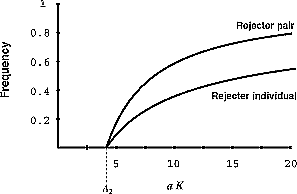Cuckoo Parasitism
Modeling the population dynamics of a cuckoo-host association and the evolution of host defenses
Fugo TAKASU, Kohkichi KAWASAKI, Hiroshi NAKAMURA, Joel E. COHEN, and Nanako SHIGESADA
The American Naturalist, 1993, vol. 142, pp. 819-839.
Abstract. - Cuckoo parasitism in Nagano Prefecture in Japan has shown dramatic changes in the parasitism rate, host usage by the cuckoo and defensive behavior of hosts during the past 60 years. To gain insights into these phenomena, we model the population dynamics of a cuckoo-host association together with the population genetics of a rejecter gene in the host population. Analysis shows that both the dynamical change in the host-parasite association and the establishment of the host's counteradaptation crucially depend on the product of two factors, the carrying capacity of the host and cuckoo's searching efficiency. When the product is less than a critical value, the host population cannot evolve a counteradaptation even if parasitized by the cuckoo. Hence, the lack of counteradaptation does not necessarily imply that the host population only recently has become parasitized. As the product becomes larger, the rejection behavior will be eventually established at higher levels in the host population. In this case, the spreading of rejection behavior is very fast, which suggests that the cuckoo-host association reaches an equilibrium state within a relatively short period. These results make possible new interpretations of several circumstances reported about cuckoo-host associations in the world.

Fig. Equilibrium frequency of rejecter individuals and pairs as a function of host abundance, aK. Rejecter individuals never go fixation because parasite can not impose parasitic pressure when the host population becomes dominated completely by rejecter individuals.
要旨
過去数十年の間日本の長野県地方において、カッコウと宿主の関係が以下の点で劇的に変化していることが報告されている:即ち、
(1)主要宿主が変化した
(2)オナガへの托卵率が地域によっては0%から80%近くまで上昇した
(3)オナガは当初対抗手段を持たなかったが最近托卵の排除行動を示し初めている
この様な現象を引き起こす機構を理解するため集団遺伝学を取り入れた個体群動態のモデルを組み立て、これを解析した。その結果、寄生者と宿主の密度変化と宿主の托卵対抗手段が確立する頻度は宿主の環境収容量 K と寄生者の探索効率 a との積に大きく依存することが明らかになった。以下に結論を要約する
1)積 a K がある値より小さい系では宿主は対抗手段を発達させることができない。一般に托卵歴が永いほど宿主の対抗手段が強化すると考えられているが、この結果は対抗手段の欠如はその宿主が最近托卵され初めたことを必ずしも意味するものではないことを示している
2)積 a K が大きい系では宿主は最終的に対抗手段を高い水準で確立し、宿主の托卵拒否行動は短い間に集団中に拡がる。このことから寄生者と宿主の関係が短期間で平衡状態に推移する可能性が示唆される
これらの結果を基に世界各地で報告されているカッコウと宿主の関係を議論し、多くの場合についてカッコウと宿主の関係は平衡状態に近いことを主張する
takasu@ics.nara-wu.ac.jp